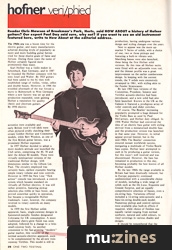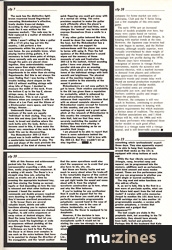Magazine Archive
Home -> Magazines -> Issues -> Articles in this issue -> View
Hofner Verified | |
Article from One Two Testing, January 1985 | |
Germanic guitars profiled
Reader Chris Mawson of Brookman's Park, Herts, said HOW ABOUT a history of Hofner guitars? Our expert Paul Day said sure, why not? If you want to see an old instrument featured here, write to How About at the editorial address.
The 1960s era was a boom time for the electric guitar, and many manufacturers achieved dizzying levels of popularity as more and more budding guitar heroes tried for those elusive goals of fame and fortune. During those years the name of Hofner certainly figured more prominently than many.
Karl Hofner was a violin maker in Schonback, East Germany, and in 1887 he founded the Hofner company with his sons Josef and Walter. By 1925 guitars had been added to the by then well-established range of violins, violas, cellos and double basses. However, in 1946 the troubled aftermath of the war forced a move to Bubenreuth in West Germany where a new factory was set up and production expanded, soon gaining Hofner a reputation for quality classic and plectrum guitars.
By 1956 electric-acoustics were available and early British rock'n'roll idols were often pictured avidly clutching their ornate Golden Hofner and Committee models, while Bert Weedon, as one of the first British guitar heroes, was a prominent Hofner exponent.
In 1957 Hofner decided to adopt a more modern attitude and launched the Club series, comprising the 40, 50 and later the deluxe 60 models. These were virtually miniaturised versions of the traditional Hofner design, with dimensions similar to the Gibson Les Paul. The circuitry employed was certainly basic, earliest examples bearing simple rotary volume and tone controls. However in 1959 the New Line "flick action" console was introduced, a control system which became standard on virtually all Hofner electrics. It was still rather primitive, featuring pickup selection plus treble or bass boost, and proved somewhat quirky in operation, but became a recognisable Hofner trademark. Later, however, the company reverted to rotary controls on many models.
In 1959 the first Hofner solids appeared, basic, single-cutaway designs in hammered-metallic finishes designated Colorama for UK consumption. A more traditional cherry-glow finish was soon adopted, followed by a change to a twin-small-cutaway body. As another concession to the fast-growing "modern" guitar market, thin versions of the normal acoustic-electrics appeared, soon to be complemented by the all-new twin-cutaway Verithin. This model is still in production, having undergone various design and styling changes over the years.
Next to appear was the more upmarket V Series of solids, with a choice of one, two or three pickups and featuring a built-in vibrato unit.
Matching basses were also launched, these being the first Hofner solid versions. By this time all Hofner necks were fitted with an adjustable truss rod, and the thinner profile was a great improvement on the earlier cumbersome design. In keeping with the current trends, the V solids were extensively revamped in 1961, with styling akin to the Fender Stratocaster.
By late 1963 bass versions of the Committee, President, Senator and Verithin acoustic-electrics had been introduced, and a new solid had also been launched. Known in the UK as the Galaxie it featured a prodigious array of roller controls and slider switches.

Of course, The Beatles' increasing popularity prompted a huge demand for the Violin Bass as used by Paul McCartney, and Hofner duly obliged. In 1956 Walter Hofner had conceived the idea of an electric bass guitar with styling derived from a miniaturised double bass and the production version was launched in that same year. However, its initial appeal proved limited, but in the mid-1960s The Beatles' connection ensured instant worldwide success, instigating a multitude of Violin/Beatle bass copies. Hofner later attempted to cash in by producing a guitar version, but this wasn't well received and was discontinued. However, the bass has remained in production to this day, becoming probably the best known of all Hofner models.
By the late 1960s the range available in Britain had been drastically reduced, but in Europe popularity continued undiminished with a considerable choice of models, including a wide range of solids such as the De Luxe, Exquisite and Grande Surprise, and an equally comprehensive selection of basses, even a six-string bass. Variations offered included a 12-string semi-acoustic and a bass/six-string double-neck model. Numerous pickup and control options were available plus built-in effects if required, while choice of finishes was equally varied ranging from normal sunburst, natural and solid colours, to vinyl coverings in various shades and designs.
It should be remembered that the British distributors at that time, Selmer, opted to import only a selection from what was a vast range of instruments, and that the model names adopted were usually designated by the Selmer company for home market use only — Colorama, Club and the V Series being just a few examples of this own-name game.
The early 1970s saw an increased choice of models available over here, but many were copies based on various established Gibson and Fender designs, in keeping with market trends at the time. However, the Japanese copy invasion had by now begun in earnest, and the Hofner versions, although usually superior, were virtually overwhelmed by sheer weight of numbers and the brand name assumed an increasingly low profile during the 1970s.
Recent years have witnessed a resurgence of interest in vintage Hofner instruments, mainly the acoustics and acoustic-electrics, with a marked increase in demand from players and collectors who appreciate the combination of attractive woods and ornate inlay work found on normal production examples of the Committee and similar models. Large-bodied semis are certainly fashionable just now, and these old Hofners combine quality and image — hence the popularity.
However, the company is still very much in business, continuing to produce up-market instruments in keeping with modern requirements but which maintain a distinct sense of tradition. The majority of Hofner associations are, and I think always will be, with the 1960s and with the many performers who employed those earlier models to such good effect.
Hofner is a vintage name with a vintage appeal, and is still deservedly popular.
More with this topic
 Buyer's Bible |
 Secondhand Taping - Recording Gear |
 Amp Guide Part 1 (Part 1) |
Electronic Percussion checklist |
 Amp Guide (Part 1) |
 Snap, Crackle, Pop & Other Noises - BUYING & USING: practice amps |
Old Gold - Music U.K. Tells You How To Buy Secondhand Gear |
 Buyers Guide |
 The Buyer's Bible |
 Buyer's Bible |
Sampler Checklist |
 Pianissimo! |
Browse by Topic:
Buyer's Guide
Publisher: One Two Testing - IPC Magazines Ltd, Northern & Shell Ltd.
The current copyright owner/s of this content may differ from the originally published copyright notice.
More details on copyright ownership...
Feature by Paul Day
Help Support The Things You Love
mu:zines is the result of thousands of hours of effort, and will require many thousands more going forward to reach our goals of getting all this content online.
If you value this resource, you can support this project - it really helps!
Donations for April 2024
Issues donated this month: 0
New issues that have been donated or scanned for us this month.
Funds donated this month: £7.00
All donations and support are gratefully appreciated - thank you.
Magazines Needed - Can You Help?
Do you have any of these magazine issues?
If so, and you can donate, lend or scan them to help complete our archive, please get in touch via the Contribute page - thanks!






